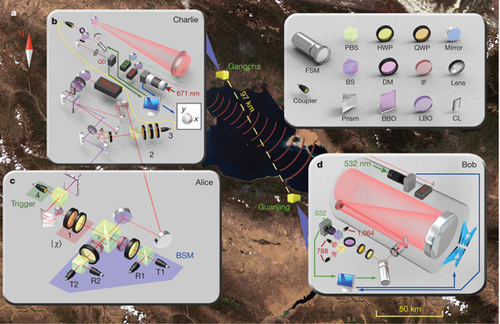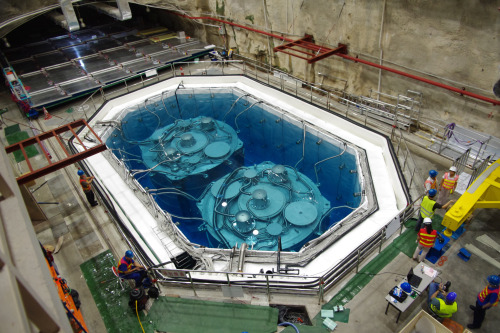

The Chinese Academy of Sciences (CAS) held a meeting in Beijing in late July to review the progress and achievements made in the implementation of the CAS Pioneer Initiative, a blueprint for the academy's development through 2030. Participants in the meeting discussed the overall and key action plans for major reforms and renovation-driven development in the foreseeable future with the aim of spurring further implementation of the initiative and CAS's 13th Five Year Plan (2016-20).
I. Twenty-five major science and technology achievements made by CAS during its 12th Five Year Plan (2011-15), are as follows:
1. Research in topological insulators and quantum anomalous Hall effect, led by the Institute of Physics
Through theoretical calculations, the researchers predicted for the first time the existence of three-dimensional strong topological insulators at room temperature. They also collaborated with the Department of Physics at prestigious Tsinghua University to observe the first "quantum anomalous Hall effect", making a key breakthrough in this field. Chinese scientists independently completed the process from theoretical research to experiments and observations.
2. Cellular programming and reprogramming, led by the Institute of Zoology
The research shed light on the mechanism of DNA methylation regulating cellular reprogramming. First transgenic animals were obtained through haploid embryonic stem cells, and animal and cellular models related to regenerative medicine were created. Moreover, the scientists obtained standardized and scalable seed cells for therapeutic use, and also made preclinical evaluations of the safety and efficacy of cell therapy.
3. Quantum communication, led by the University of Science and Technology of China
The scientists systematically developed photon manipulation technology and applied it creatively to multiple research branches of quantum information processing, which catalyzed quantum communication development targeting high data transfer rates, longer communication distances and interconnected networks. Thanks to its innovative achievements, the research was selected as one of the world's most significant advances in physics, and won the First-Class Prize of China’s National Natural Science Award in 2015. China has developed the world's state-of-the-art quantum communication technologies.

Figure: Free-space quantum teleportation (Images from cas.cn)
4. Research in particle physics focusing on charm physics and neutrino physics, led by the Institute of High Energy Physics
The BESIII collaboration experimentally observed a charged Zc (3900) signal that appeared to contain at least four quarks. Possibly an exotic particle long sought after by scientists, it drew wide attention from across the world. The Zc (3900) was selected as the top story of 2013 by the American Physical Society. In 2014, a new charged resonance, Zc (4020), was observed.
The Daya Bay Reactor Neutrino Experiment collaboration discovered a new type of neutrino oscillation and accurately measured the amplitude of oscillation. The finding was viewed as "a milestone in neutrino physics", and picked by Science magazine as one of the top ten breakthroughs of 2012. Afterwards, the collaboration completed measurement of the differences between squared neutrino masses, high-precision analysis of θ13, and sterile neutrino analysis.

Figure: Neutrino detectors successfully installed in a giant pool
5. Flow battery for energy storage – key materials and new technology, led by the Dalian Institute of Chemical Physics
The new energy storage technology resolved the bottleneck of grid instability attributable to fluctuating renewables. The safe, reliable and environmentally friendly vanadium flow battery, developed by the Dalian Institute of Chemical Physics, boasts a long service life and a large energy storage capacity. Key issues with regard to battery materials, cell stacks and energy storage system integration were also addressed. The technology emerged from basic research and gave birth to a whole new industry.
6. Congruent number problem and Langlands program, led by the Academy of Mathematics and Systems Science
Research in number theory made important achievements. On the congruent number problem, "the oldest unsolved major problem in number theory", researchers discovered the existence of an infinite number of congruent numbers with an arbitrary large number of prime factors. An international scholar said the finding "is an important milestone in the history of this ancient problem". On the Langlands program, one of the major mathematical challenges of the 21st century, the researchers resolved the three basic problems in the theory of theta correspondences and the multiplicity one conjecture.
7. Deep ultraviolet (DUV) crystal devices, laser light sources and applications, led by the Technical Institute of Physics and Chemistry
The research team made the first breakthrough in the world in developing the technology for growing large-size KBBF, a non-linear crystal used in optical applications, as well as sophisticated and practical DUV all-solid-state laser technology. Based on these core technologies, the team developed eight new scientific instruments, and made innovations to the operation research model in the frontiers of this wavelength range. The success was a typical example of China's independent research and development of sophisticated devices using high technology.
Figure: Practical DUV all-solid-state laser, developed by the Technical Institute of Physics and Chemistry
8. Green plate-making technology based on nanomaterials, led by the Institute of Chemistry
The technology addressed three major pollution concerns arising from the printing industry's plate-making processes which cause waste of photosensitive materials, waste electrolytes from electrolytic oxidation of the plate base, and VOC emissions from solvent-based inks. The new printing technology utilizes a green plate base, green plate-making and green inks, and is viewed as a major technological breakthrough comparable to computerized laser photocomposition systems for the typesetting of Chinese characters. The research achievement has been commercialized, benefiting major strategic emerging industries including printed electronics and 3D manufacturing, green dyeing and printing, and building materials.
Figure: Green plate-making device NT220-116C
9. Studies on the relationships between structure and function of eukaryotic membrane proteins and multiprotein complexes, led by the Institute of Biophysics
The researchers analyzed the high-resolution three-dimensional structure of the DNA double helix in chromatin, one of the most challenging structures identified to date. They also explained the mechanism of toxin assembly and transport in bacteria, which paved the way for developing new types of antibiotics against "super bacteria". The researchers also discovered the structures of the viruses that cause hand-foot-mouth disease (HFMD) and hepatitis A, as well as the molecular mechanisms underlying the infections, which lays a structural foundation and sets directions for the research and development of new viral drugs and vaccines.
Figure: The "life machine" counts on the dozens of thousands of biomacromolecules and their complexes in cells to facilitate its smooth operations.
10. Breakthroughs in key technology of a thorium-based nuclear power system, led by the Shanghai Institute of Applied Physics
R&D of prototype systems and key technologies of the Thorium Molten Salt Reactor Energy System (TMSR) program started from scratch and made breakthroughs in all areas. Preliminary design of the 10MW solid-state fuel molten salt experimental reactor project was completed and approved by the National Nuclear Safety Administration as a Class II experimental reactor, while pilot-scale preparation of key new materials was achieved. These accomplishments laid a solid technical foundation for China’s building of the world's first experimental reactor.
11. Research on targets in neurological diseases, led by the Shanghai Institutes for Biological Sciences
A model of transgenic monkey that exhibited autism-like behavior was constructed, providing a non-human primate model for further studies on brain diseases. Dopamine receptors were found to play a key role in suppression of neuroinflammation. The finding offers valuable assistance in choosing the right targets, slowing down brain aging and even intervening in neurodegenerative diseases, and lays an important foundation for the prevention, diagnosis and treatment of brain diseases.

Figure: A new mechanism underlying the "recycling" of the neurotransmitter dopamine and its relationship with cocaine addiction, Vav2, which regulates GDNF signaling, was found to play a key role in the addiction’s formation, and offers a new insight into drug addiction control.
12. Major progress made in GPCR drug target research, led by the Shanghai Institute of Materia Medica
GPCRs are among the most important drug targets in protein families. The researchers set up a world-class platform to study the structures and functions of GPCRs, and identified their crystal structures for the first time in China. Besides, they addressed several scientific challenges in cell signaling. In R&D of drugs targeting GPCRs, three lead compounds entered preclinical research and technology transfer was completed.
Figure: The world's most powerful laser lights on GPCR-arresting signaling pathway
13. Large evaporative cooling hydro-generator, led by the Institute of Electrical Engineering
China's self-developed evaporative cooling technology was applied for the first time to the world's largest capacity hydro-generator, a sign of China's leading position in R&D of large power equipment. The facility brought great economic benefit during four years' operation. The innovative and original technology, unique in the world, marked a major breakthrough in cooling systems.
14. High-temperature superconductivity and nanomaterials, led by the University of Science and Technology of China
The researchers discovered an iron-based superconductor, the first non-copper-oxide superconductor with a transition temperature beyond the McMillan limit (39 K). The iron-based superconductor was proved to be a new unconventional high-temperature type. Furthermore, breakthroughs were made in research into the methodology of nanoscale building blocks' controllable synthesis and their assembly and large-scale preparation, as well as related devices.

Figure: High-mobility two-dimensional electron gas in black phosphorus thin films
15. Molecular reaction basis and devices, led by the Institute of Chemistry
Graphyne shows good chemical stability and semi-conductive performance. Its application has huge potential in IT, electronics, energy, catalysts and optical electronics. The research team synthesized graphyne on a copper surface, the first example of artificial chemical synthesis of an allotrope of carbon. The achievement inspired international research in this field, and also drew wide attention from the business community.
16. Structure nano-crystallization science and technology for metal engineering materials, led by the Institute of Metal Research
The research discovered the strengthening effect of nano twinning, which ushered in research into nano-twinned materials. A new theory for the strengthening effect of nano twinning was also proposed. Pioneering studies were conducted in surface nano-crystallization of metal materials and materials with a gradient nanostructure, which significantly improved the comprehensive performance of the materials. Moreover, the researchers discovered a new type of super-hard and ultra-stable nano-layer structure in metals.
17. Plant carbon and nitrogen metabolisms and improvement, led by the Shanghai Institutes for Biological Sciences
The research discovered the key mechanism that regulates plant development processes and allocation of energy and matter, and constructed a comprehensive map of rice genome variation, which shed light on the origins and domestication processes of cultivated rice. The study also explained the molecular genetic mechanism that controls the formation of rice's complicated properties. The findings have been applied to molecular design-assisted breeding, which provides technological support for sustaining high yields, excellent quality and high productivity in the agricultural sector.
Figure: ERECTA significantly improves transgenic plants' resistance against unfavorable conditions
18. Mechanisms underlying biological crises outbreaks, and their control and prevention, led by the Institute of Zoology
The researchers decoded the whole genome sequence of Locustamigratoria, a widespread locust species, and explained the genomic basis for their aggregation. They also discovered the molecular regulation mechanism underlying the transformation from a well-hidden solitarious phase to an overtly noticeable gregarious phase. They also proposed theories of symbiotic and return invasion by major invasive species. A manufacturing base for pesticides against insect viruses, boasting the largest capacity to date, was built, and 11 certificates of new pesticides obtained. The move benefited 6 million hectares of crops and reduced the use of chemical pesticides by 9,000 metric tons.

Figure: Draft genome sequence of Locustamigratoria
19. Health effects and control of environmental pollution, led by the Research Center for Eco-Environmental Sciences
Through studying the mechanism of population exposure to regional environmental pollutants and the molecular mechanism of health hazards, the researchers proposed a roadmap for China's environment and health research. The study laid theoretical and methodological foundations for discovering the causes of regional high incidences of certain diseases attributable to environmental pollution and the development of health enhancement technologies.
Figure: Mechanism of nano silver changing cellular energy metabolism
20. Priority Program on Space Science, led by National Space Science Center
The Priority Program on Space Science is China's first scientific satellite program aimed at major scientific discoveries. After launching in December 2015, the Dark Matter Particle Explorer (DAMPE), the first satellite under the program, worked normally and obtained scientific data. In his 2016 New Year speech, Chinese President Xi Jinping mentioned DAMPE's launch, which also drew wide attention from the international community.

Figure: China's first Dark Matter Particle Explorer (DAMPE) in orbit
21. Discovery of an iron-based high temperature superconductor above 40K and research into its basic physical properties, awarded the First-Class Prize of China’s National Natural Science Awards, with the Institute of Physics as a major contributing unit.
Researchers from the Institute of Physics and the University of Science and Technology of China won the First-Class Prize of China’s National Natural Science Award in 2013 for their creative work. Their effort also inspired a new round of research into high temperature superconductivity. Science magazine published a review of the finding, "New Superconductors Propel Chinese Physicists to Forefront".
Figure: Basic structures of iron-based superconductor's iron/arsenide or iron/selenium layer
22. DMTO technology honored with the First-Class Prize of the National Award for Technological Invention, with the Dalian Institute of Chemical Physics as a major contributing unit.
The DMTO Technology offers a new coal-to-olefins solution. China is the first country in the world to commercialize the technology, which will lead strategic emerging industries to faster growth. So far, 20 groups of industrial facilities have been licensed to use the technology, with nine already in operation, and it is anticipated that they will inspire estimated investment of 250 billion yuan. The technology is of great significance to the optimization of the structure of the Chinese chemical industry as well as the country's energy security.
Figure: Shenhua Group’s MTO facility in Baotou
23. Launch of Chinese Ecosystem Research Network (CERN), observation/research/experiment demonstration, granted First-Class Prize of the National Science and Technology Progress Awards, with the Institute of Geographic Sciences and Natural Resources Research as a major contributing unit.
The program constructed a theoretical system to support China's effort to build a network platform for its eco-environmental field stations, and accumulated observation data from the stations to track changes in the Chinese ecosystem. It also organized integrated research and demonstration models on key technologies for the protection and restoration of the eco-environment and efficient agricultural production. In the past two decades, the program has systematically helped to resolve major science and technology issues faced by the country's eco-environmental protection and improvement programs and those fostering agricultural modernization and sustainable growth, and also made significant contributions to the basic innovative research platforms in the environment and resources field.
Figure: Scientists examine a China fir forest in which the average tree age is nearly 80 years
24. Shanghai Synchrotron Radiation Facility (SSRF), awarded the First-Class Prize of the National Science and Technology Progress Awards, with the Shanghai Institute of Applied Physics as a major contributing unit.
SSRF is a major national infrastructural facility in science and technology meeting advanced international standards. It has long been in stable and efficient operation, making remarkable achievements in the frontiers of basic research as well as R&D of high and new technologies in life science, material science, chemistry and environmental science. SSRF has propelled the development of relevant disciplines, and become an essential research platform to boost the country's science and technology development.
25. Experimental Advanced Superconducting Tokamak (EAST) innovation team at the Hefei Institutes of Physical Science, honored as an Innovation Team of the National Science and Technology Progress Awards.
Fusion power, one of the most ideal clean energies, is of strategic significance to China's sustainable development. The EAST team conducted research in the frontiers of fusion science before they independently designed and built the world's first all-superconducting tokamak device, which realized long-pulse high temperature plasma operations. The research made a series of world-leading achievements. The team was honored for their innovative contributions to the development of fusion science and technology, which made China one of the world's leaders in research of superconducting tokamaks.
Figure: Superconducting tokamak
II. CAS to forge upgraded Pioneer Initiative
1) A faithful, reliable and responsible talent team will be forged.
2) The academy will actively plan for its medium and long-term reform and innovation-driven development, and accelerate implementation of the Pioneer Initiative. Through the initiative CAS aims to achieve the "Four Firsts" – first in achieving leap-forward development in science and technology, first in building the high grounds for cultivating innovative talents, first in establishing a high-quality science and technology national think tank, and first in building internationally leading research institutes.
3) The Beijing and Shanghai science centers, along with the Hefei Comprehensive National Science Center, will be at the forefront of efforts to accelerate the construction of first-class national innovation centers.
4) CAS will push ahead with the restructuring of its research institutes, and gradually construct a system in which the headquarters oversees overall strategy, regional or field institutions oversee tactics, and four types of institutions/research institutes oversee implementation.
5) The academy will seize opportunities and implement action plans to cultivate more innovative talents.
6) A special program will be launched to deepen the integration of science and education and build world-class universities.
7) CAS will further improve organization and management mechanisms as it becomes a high-level national think tank.
8) CAS will consistently provide science and technology support to the Belt and Road Initiative, and take the opportunity induced by the initiative to form a new pattern of global science and technology cooperation.
Source: cas.cn